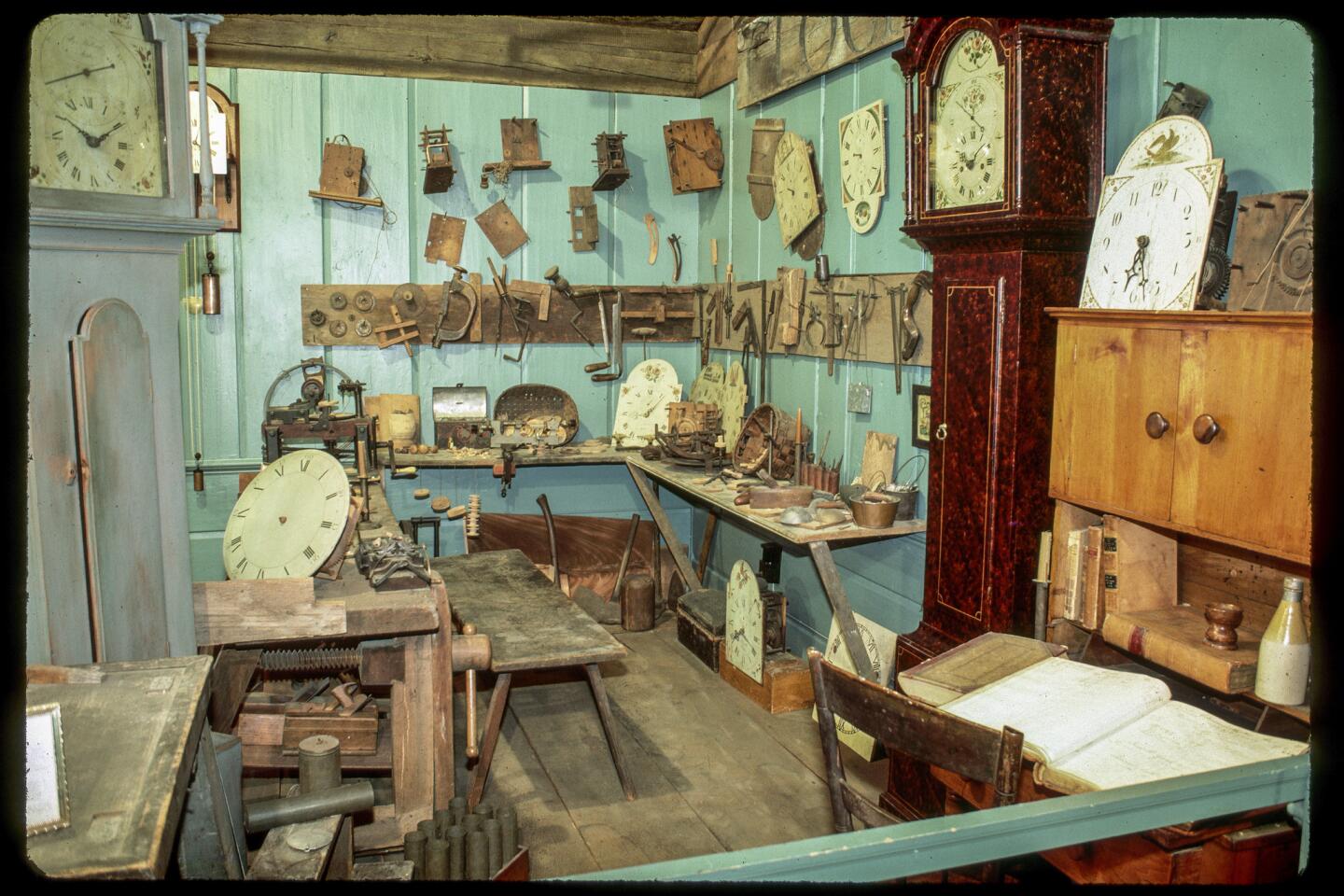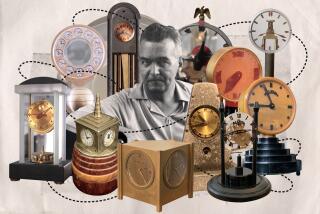Is it time to see Connecticut? If you’re chronometrically inclined (you like clocks and such), this is the place for you
Reporting from Plymouth, Conn. — Members of Plymouth’s First Congregational Church don’t bother looking at the clock just below the church steeple to see whether they’re on time for Sunday services.
The clock was donated to the newly built church nearly 180 years ago by Eli Terry Sr., one of Connecticut’s first, and most prominent, clockmakers. But locals no longer rely on it.
“I was walking in the cemetery a few days ago around 9 a.m. and it chimed seven times,” the Rev. Denise Clapsaddle said. “One of our members joked that unlike a stopped clock, it isn’t even right twice a day.”
Efforts to repair the clock, with its massive gears carved from local wood, have failed. Yet it towers over the surrounding countryside as an off-kilter tribute to the area that was once the center of clock and watchmaking in America.
No longer. Nearly all manufacturing has moved overseas, save a handful of folks who make high-end custom watches.
But it’s easy for visitors to chronicle Connecticut’s timepiece timeline, from the hand-crafted clocks of the 18th century to the mass-produced watches of the 20th century, including millions featuring a mouse named Mickey.
Starting time
Beginning a half-an-hour’s drive from Hartford, visitors can create their own self-paced time trail that more or less follows U.S. 6 west through Bristol, Terryville, Plymouth and Thomaston before heading south to Waterbury on Connecticut 8. Allow a couple of days to absorb the history of a region once known as “the Switzerland of America.”
Clockmaking flourished in this area from the late 18th century onward, thanks in part to an abundance of timber from forests, said Tom Manning, curator at the American Clock & Watch Museum in Bristol.
Over the years wooden gears were replaced by metal parts from the brass works for which the area is also known.
Manning is, at times, difficult to hear over the incessant ticktocks and the chiming and clanging on the hour and half-hour. He oversees a collection of about 5,500 timepieces, nearly all made in Connecticut.
About 1,500 are on display at any given time in eight galleries. When Manning heads home, he has 250 more timepieces in his personal collection awaiting attention.
“It’s a terrible disease,” he said, only half-kidding, of his compulsion for clocks. Even his license plates read “CLOCKS.”
The museum honors Connecticut’s many clock and watchmakers, but none is probably more important than Eli Terry Sr.
Terry, trained by an English clockmaker, was awarded the first of his 10 patents in 1797. Five years later, he made his mark on the Industrial Revolution by inventing the first clocks with interchangeable parts.
The mass production of clocks had begun.
Using power generated by a still-standing water wheel, Terry and his offspring began making affordable clocks by the thousands instead of pricey ones by the dozen.
His final creation, a wall clock made shortly before he died in 1852, is one of about 25 of Terry’s clocks in the museum collection.
The once-bustling Terry factory is long gone, but it’s easy to find the historic water wheel along Terryville’s Main Street (U.S. 6), where it once harnessed the water of the Pequabuck River.
If you head west, the Plymouth Congregational church with its Terry clock is 2½ miles farther, a bit north of U.S. 6 on Park Street. Travel one more mile to reach Thomaston, home to clock and watchmaker Seth Thomas.
The Seth Thomas factory is now an office park, but it is tangible evidence of the once-thriving industry.
Thomas, who learned his trade from Terry, began making clocks in 1813.
The Seth Thomas-Bradstreet House, which Terry built in 1838, is a few blocks up Main Street. It remained in the family until 2005 when the town of Thomaston bought it. It’s decorated with period furnishings, including a Seth Thomas tall clock.
Waterbury, 10 miles south, is nicknamed the Brass City because its foundries once supplied a thriving clock and watchmaking community.
A clock and watch exhibit at the Mattatuck Museum reveals a hint of the city’s history. It inherited timepieces from Timexpo, the Timex company’s museum that closed in 2015. (The Timex headquarters remains in nearby Middlebury.)
“The legacy of the Waterbury Clock Co. [later Timex] has always been making these durable, inexpensive timepieces that the common man could purchase,” said Carl Rosa, Timexpo’s former director. They were “mass-produced, assembly-line processed, affordable watches, not fine Swiss watches,” he said.
Rodent to the rescue
Local companies began producing pocket watches in the early 1900s, Rosa said, a couple of decades before wristwatches became popular, thanks, in part, to a cartoon character.
“Had it not been for Mickey Mouse, we wouldn’t be sitting here having this conversation,” Rosa said.
Ingersoll, a Waterbury Clock brand, partnered with Disney during the Great Depression to put the famous rodent’s image on pocket and wristwatches.
“Of course, the hour and minute hands were Mickey’s hands,” Rosa said. “It was a hit.…A year later, they were making millions of them.”
Thousands of unemployed people were put to work manufacturing the watches.
“It… saved the company,” Rosa said.
Early examples of the cheery watches, introduced in 1933, are on display in the Waterbury and Bristol museums.
The big factories may be closed, but that doesn’t mean watchmaking has left the state.
Werner Janer turns out a handful of timepieces each year in his shop in Oxford, 13 miles south of Waterbury. He proudly displays “Connecticut” directly beneath the brand name: Naugamatic, named after the area’s Naugatuck Valley.
“My store is like a working museum,” Janer said of the shop. He welcomes visitors to drop by for a history lesson while watching older watches being repaired and new ones being assembled.
“I have a very fine collection of working lathes,” he said. “In the back room, I have a Swiss lathe where I make pocket watch cases.
“If you think watchmaking is a dying art, then clockmaking is a deathbed art.”
Although modern timepieces are easy to reset when it’s time to “fall back,” the process is a huge headache at Connecticut’s museums.
“Setting the clocks ahead for springtime is not an issue. You advance the hands an hour,” said Rosa, the former Timexpo boss. “But these brass movements were not designed so that you could reverse the hands.
“I left the museum about 12 or 13 years ago. I just finished [setting] my last clock yesterday,” he said with a smile.
If you go
THE BEST WAY TO HARTFORD, CONN.
From LAX, American offers nonstop service to Hartford, and Southwest, United, Delta, American and Jet Blue offer connecting service (change of planes). Restricted round-trip airfares from $330, including taxes and fees.
American Clock & Watch Museum, 100 Maple St., Bristol, Conn.; (860) 583-6070. Open daily through Nov. 23, then Fridays-Sundays through March 31. Admission is $6 for adults, $3 for children 8-17 and free for those 7 and younger. On the first and third Fridays of each month, visitors are welcome to join a group of volunteers known as “the old cranks” as they walk through the museum, making needed adjustments to dozens of clocks.
Seth Thomas-Bradstreet House, 237 Main St., Thomaston, Conn.; (860) 283-5253. Open Saturdays during May, June, September and October with guided tours at 11 a.m., noon, 1 and 2 p.m. Admission is free.
Mattatuck Museum, 144 W. Main St., Waterbury, Conn.; (203) 753-0381. Open 10 a.m.-5 p.m. Tuesdays-Saturdays, noon-5 p.m. Sundays. Admission is $10. Children 16 and younger are free.
Naugamatic Watch Co., 308 Oxford Road, Oxford, Conn.; (203) 873-8108. Open 10 a.m.-6 p.m. Tuesdays-Saturdays.
More to Read
Sign up for The Wild
We’ll help you find the best places to hike, bike and run, as well as the perfect silent spots for meditation and yoga.
You may occasionally receive promotional content from the Los Angeles Times.







